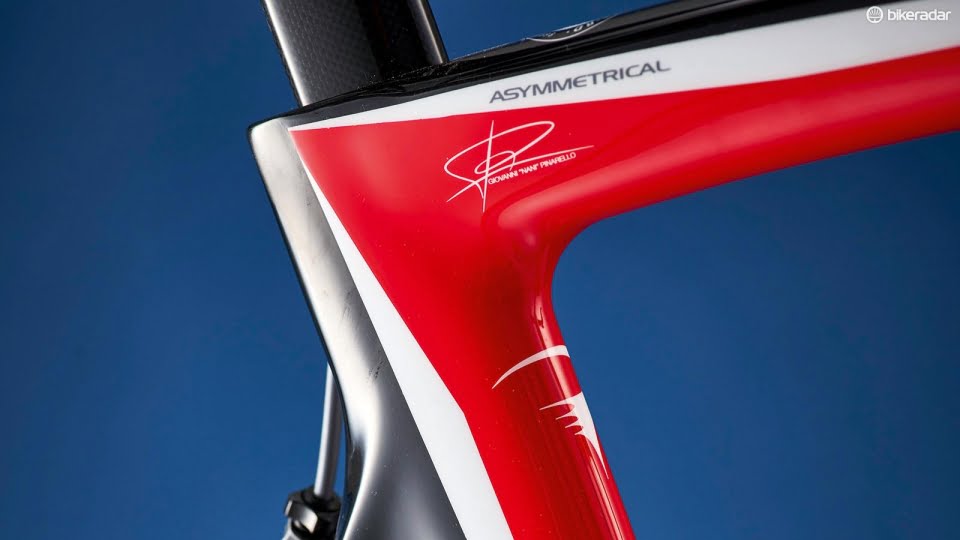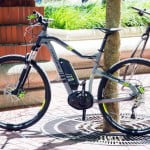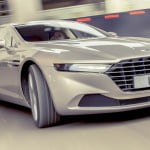Pinarello’s Dogma F8 appeared beneath Chris Froome and his Sky teammates ahead of the 2014 Tour de France – and with Froome now in pretty exalted company after this weekend’s second TdF victory in three years, you’d have to say it’s been a successful partnership so far.

Replacing the previous Dogma 65.1, which was regarded by some as overly rigid, the F8 largely does away with the old machine’s wiggly tube shapes, concentrating instead on wind cheating.
There’s stunning attention to detail all over the frame, from the lustrous glossy paint finish to the incredibly well routed cables and two alternative seat tube bottle cage positions for convenience or reduced drag. The slim fork legs are curved well away from the front wheel for less turbulent airflow, using an idea derived from the track, and the crown’s shape is intended to closely match that of the brake caliper.
The f8’s asymmetric frame is claimed to balance out pedalling forces for greater efficiency: the f8’s asymmetric frame is claimed to balance out pedalling forces for greater efficiency
The F8’s asymmetric frame is claimed to balance out pedalling forces for greater efficiency
The down- and seat tube plus seatstays and seatpost all feature Pinarello’s Flat Back shaping, which is essentially another name for the recognised Kamm Tail design, and the rear brake is shielded from the breeze by a specifically-shaped monostay.
The seat tube, down-tube and top tube are all asymmetric in section and position to balance out pedalling forces and increase frame stiffness, and the similarly asymmetric rear triangle improves lateral stiffness. Claimed figures are nine percent lighter and 28 percent stiffer than the Dogma 65.1.
It’s a simple and elegant design, not overly aggressive or angular, but it incorporates all of the features expected of a current Grand Tour contender. A complete Shimano Dura-Ace Di2 drivetrain keeps things neat and tidy, and there’s an Italian threaded bottom bracket shell for simplicity.
What really matters though is how the F8 performs, and thankfully it does that very well indeed. From the outset, those oversized aero tubes deliver a completely unexpected ride quality, with smoothness befitting a bump-levelling endurance bike, and simply excellent composure. Big hits, corrugations and rough roads have little effect on rider comfort, which is exceptional, especially considering the ultra-rigid Fulcrum Racing Zero wheelset and 23mm tyres.
As you’d expect for this sort of money, there’s a full raft of shimano dura-ace di2: as you’d expect for this sort of money, there’s a full raft of shimano dura-ace di2
As you’d expect for this sort of money, there’s a full raft of Shimano Dura-Ace Di2
Standing on the pedals reinforces the seated feeling of absolute solidity, all of the asymmetric features working together to give a completely balanced experience when accelerating. Sprinting on the flat, attacking on a climb, or firing out of a corner, the F8 feels so urgent, with no lag between pedal strokes, no undue flex, and everything focused on rapid forward motion.
The chassis is so good that it’s a dream to ride with 23mm clinchers, and fitting wider rubber and/or tubulars just makes it better.
Through the corners, it’s perfectly predictable, the plentiful road feel seemingly giving you more time in the bends to pick and correct your line, and the frame’s suppleness maximising grip. On a long ride, the F8 looks after you better than almost all current aero machines, and is as comfortable as the very best all-round road bikes, which is as impressive as it was unexpected.
In every criteria it blows the old Dogma away – and definitely offers Team Sky more than a marginal gain.
This article was originally published in Cycling Plus magazine available on, Apple Newsstand and Zinio
Robin began road cycling in 1988, and with mountain bikes in their infancy, mixed experimental off-road adventures with club time trials and road races. Cyclocross soon became a winter staple, and has remained his favourite form of competition. Robin has always loved the technical aspect of building and maintaining bikes, and several years working in a good bike shop only amplified that. Ten years as a Forensic Photographer followed, honing his eye for detail in pictures and words. He has shot at the biggest pro events since the ’90s, and now he’s here, drawing on all those experiences to figure out what makes a bike or component tick.
[“source-bikeradar”]





